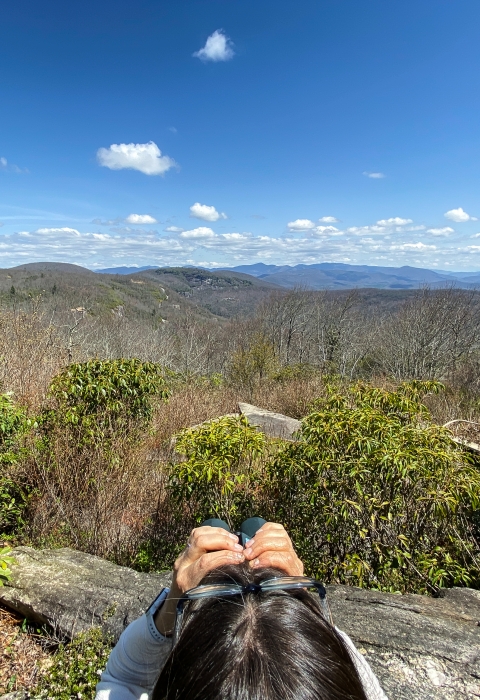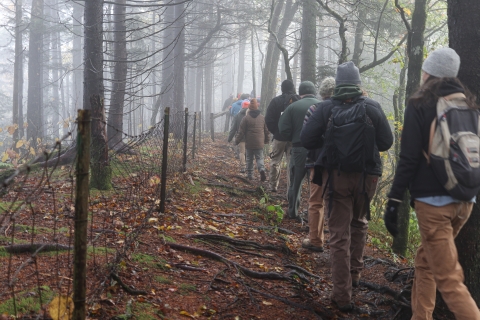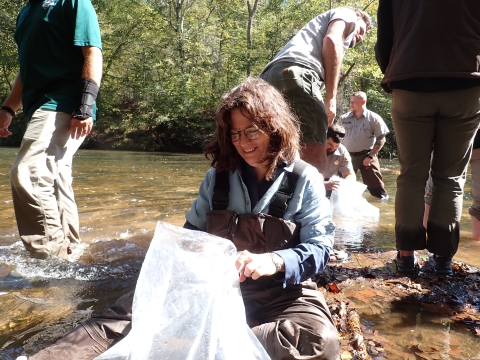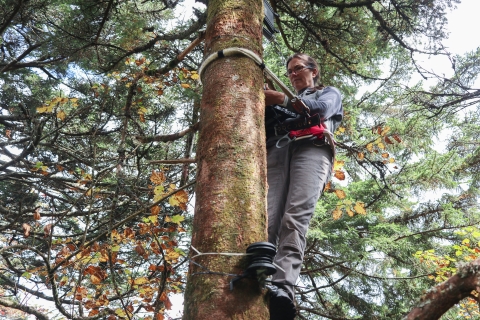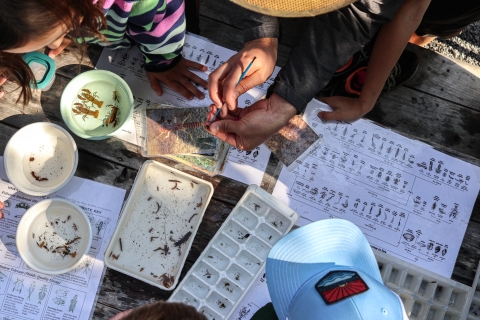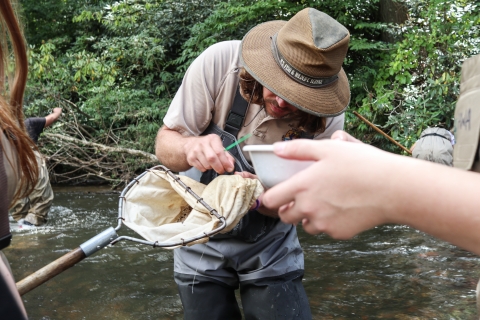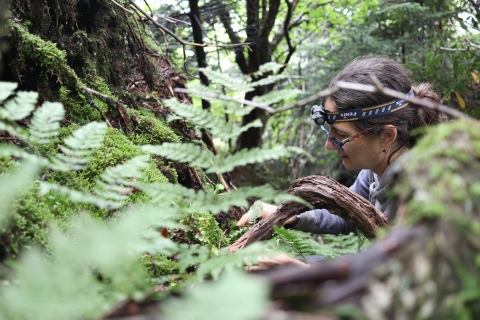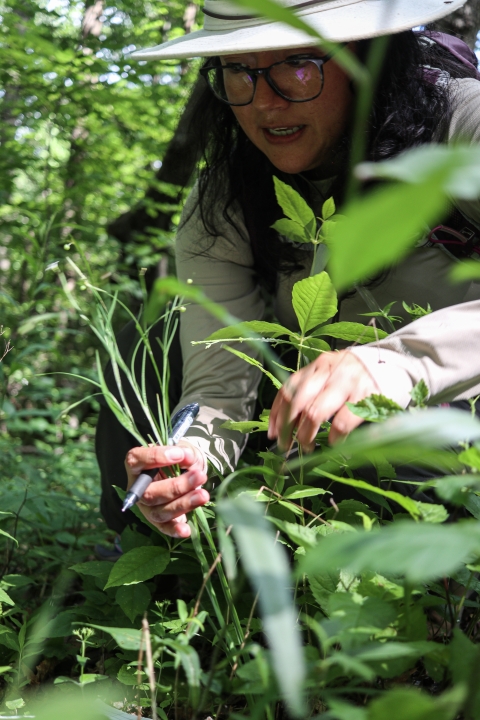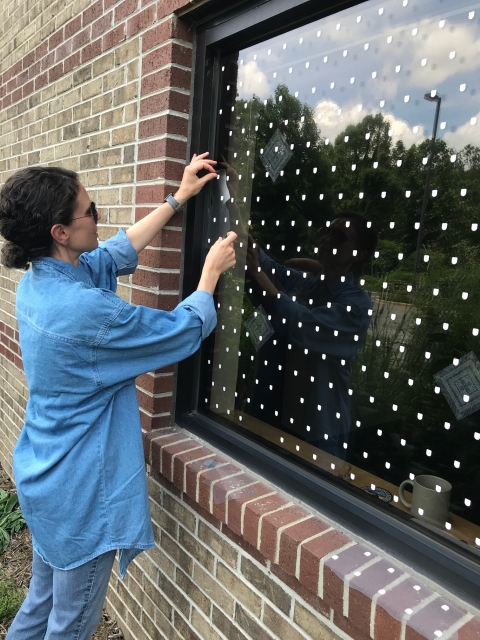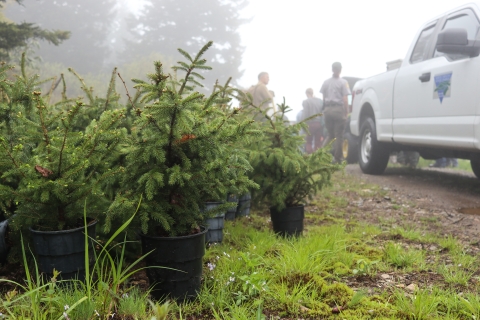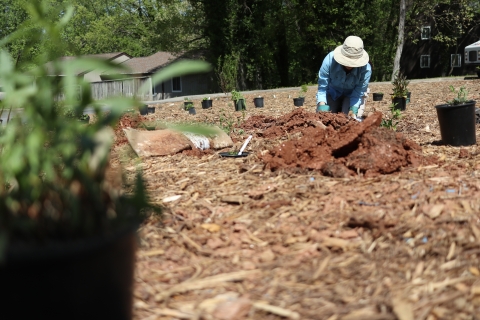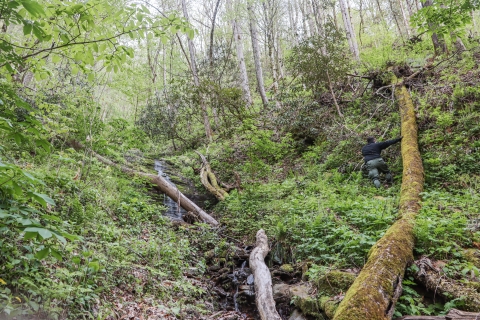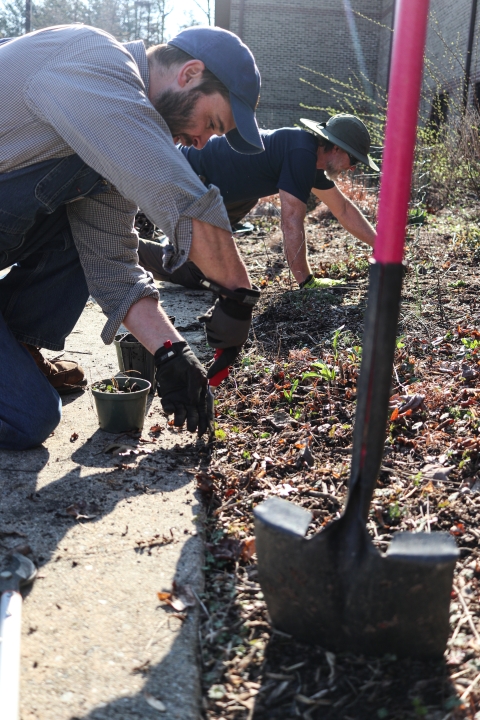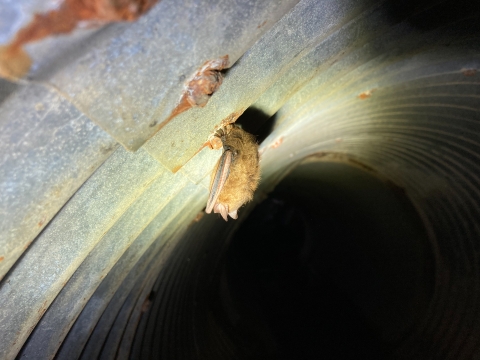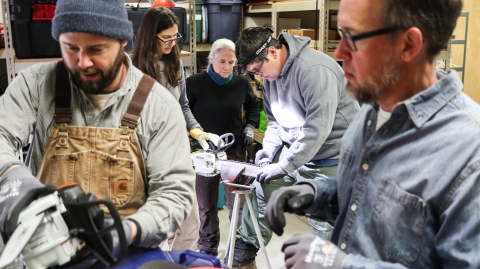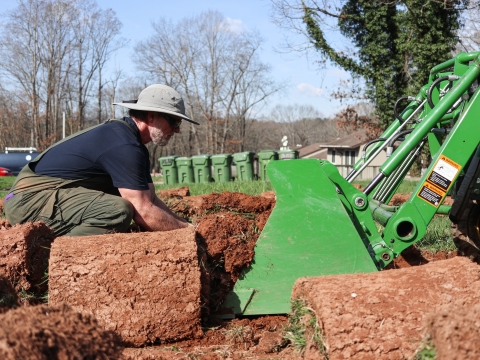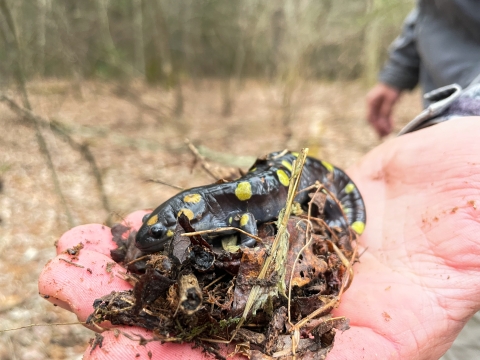December 8
Talking recovery – Dr. Natali Ramirez-Bullon, listing and recovery botanist with the Asheville Field Office, recently spoke to the office on her recovery work. The brown-bag seminar is the latest installment of an ongoing effort at the Asheville Field Office where staff present on their work to fellow staff, helping ensure everyone understands the breadth of the office’s work. It also provides a forum for conversation about more nuanced portions of each program.
Mental health first aid – Asheville Field Office staff Andrew Henderson, Janet Mizzi, and Gary Peeples attended a one-day mental health first aid certification class offered by Asheville-Buncombe Community College. The class covered various types of mental health issues, how they may manifest themselves, and how and when to respond when someone is in crisis. Staff member Dr. Natali Ramirez-Bullon helped facilitated Service participation in the training.
November 23
Tan riffleshell range – Asheville staff Mark Endries and Andrew Henderson recently updated the range map for the tan riffleshell, an extremely rare mussel that has been on the federal endangered species list since 1977. The update is part of a broader effort to overhaul the range maps for threatened and endangered species, aligning them with key ecological features (e.g. watersheds) instead of political boundaries (e.g. counties), providing a more accurate representation of where the species may be found.
November 17
Brownbag lunch – Rebekah Reid, consultation team lead for the Asheville Field Office, presented on federal project review under the Endangered Species Act to fellow Asheville Field Office staff. The presentation was the first in a winter-long brown-bag lunch series aimed at familiarizing all staff will the spectrum of work done by the office. Future presentations will focus on listing and species status assessments, imperiled specie recovery, hydropower relicensing, as well as plant and pollinator conservation.
Field ecology panel - Asheville Field Office biologist Andrew Henderson virtually visited a graduate level field ecology and methods class at North Carolina State University. Andrew joined staff from the U.S. Geological Survey, N.C. State University, and the N.C. Museum of Natural Sciences, answering questions about the intersection between field ecology data and agency actions.
French Broad River Partnership – Area agency and NGOs staff, business leaders, and elected officials came together to discuss the importance of the French Broad River at the annual French Broad River Partnership fall meeting, held recently in Asheville, N.C. The partnership is the preeminent group bringing together stakeholders on the North Carolina side of the river basin, which straddles the North Carolina-Tennessee state line. Janet Mizzi and Jason Mays of the Asheville Field Office represented the Service.
New pollinator garden at Polk Central Elementary School – Students at Polk Central Elementary School, in Polk County, N.C. have a new pollinator garden. Asheville Field Office biologist Bryan Tompkins worked with staff from the school and local non-profit Champions for Wildlife to plan the garden, which was installed by students with the help numerous volunteers and Asheville Field Office supervisor Janet Mizzi.
November 10
State-wide planning – The Asheville and Raleigh Ecological Services field offices recently completed a two-day retreat in Winston-Salem North Carolina. The retreat focused on two areas: first, simply forging personal relationships, especially with staff hired since the beginning of the COVID pandemic; and secondly, bringing staff together to start conversations about closer coordination moving into the future.
Teaching about the Endangered Species Act – Asheville Field Office biologist Andrew Henderson recently helped teach the Service’s class on "listing," or the process for placing species on the federal threatened and endangered species list. This is Henderson’s second time helping with the class, which was offered at the Service’s National Conservation Training Center in Shepherdstown, WV. This time he taught modules on what can be considered for listing, the factors to consider when listing, using best available science, critical habitat prudency and determinability, and outreach.
New pollinator garden at Johnston Elementary School – Western North Carolina's Johnston Elementary School is home to a new pollinator garden thanks to the work of Bryan Tompkins, biologist with the Asheville Field Office. The garden is the latest in a long-term effort by Tompkins to engage schools in pollinator conservation, an effort that has resulted in the development of a pollinator curriculum by Service partners and several more school gardens slated for installation.
November 3
Bats and Brews – Bat week was marked in Western North Carolina with Bats and Brews, an educational event hosted by Sierra Nevada Brewing Co. in Mills River, N.C. More than 100 people turned out for the evening event, which featured a documentary showing, guest speakers, and information tables. Asheville Field Office biologist Sue Cameron joined biologists and staff from the N.C. Wildlife Resources Commission, U.S. Geological Survey, U.S. Forest Service, and National Park Service in providing information to the public.
October 27
Spruce restoration annual meeting – The fall meeting of the Southern Appalachian Spruce Restoration initiative was recently held at Great Smoky Mountains National Park, with Asheville Field Office staff Gary Peeples and Sue Cameron rolling out of leadership positions, and Mark Endries continuing the partnership’s steering committee. The annual in-person meeting focused on efforts to expand restoration work on National Forests and to expand the partnership’s capacity via a dedicated coordinator.
Learning to use and analyze geographic data – Kurt Snider, of the Tennessee Field Office, and Mark Endries, of the Asheville Field Office, took their Introduction to ArcGIS Pro class on the road again, providing it to staff of Piedmont National Wildlife Refuge and the Georgia Department of Natural Resources. ArcGIS Pro has become the Service’s standard geographic information system, allowing users to analyze and display data with a geographic component. The pair previously offered the class in Asheville, NC; Athens, GA; Charleston, SC; and Cookeville, TN.
October 20
Roanoke logperch release – Endangered Roanoke logperch were reintroduced to the Mayo River, in Rockingham County, N.C. The rare fish were spawned by Conservation Fisheries, Inc., a Knoxville-based non-profit specialized in propagating rare fishes, grown out in a state hatchery, then released at a site owned by the Piedmont Land Conservancy. Asheville Field Office staff Jason Mays and Janet Mizzi turned out for the release, which was facilitated by an agreement they helped develop with the state of North Carolina to pave the way for increased aquatic species conservation across the state.
Updated ranges maps for three Cumberland mussels – Asheville Field Office biologists completed work defining the OneRange of the Tennessee Pigtoe, Tennessee clubshell, and Cumberland moccasinshell – three mussels that have been proposed for protection under the Endangered Species Act. The OneRange is what the Service considers the official range of a species and is based on ecological features – a departure from the past when the Service would categorize a plant or animal’s range by county boundaries.
Pollinator teacher workshop –Twenty-three Buncombe County, N.C. science teachers turned out for a pollinator workshop hosted by the school district and Asheville Field Office biologist Bryan Tompkins. The workshop merged Tompkins’s creation of a pollinator conservation outreach program with public schools that includes the installation of pollinator gardens at area schools with the development of a K-12 pollinator curriculum by the school system and local non-profit Champions for Wildlife. The curriculum is developed to meet NC Department of Education standards and contains art education components. Four county schools are slated to install pollinator gardens this fall, with another seven slated for spring installation.
October 13
Project review summary – Under the Endangered Species Act, federal agencies review projects they fund, authorize, or implement for impacts to threatened and endangered species, and if they find such species may be affected, they consult with the Service to reduce or eliminate those impacts, with the Asheville Field Office reviewing projects in the western half of North Carolina. Numbers are in for the 2023 federal fiscal year, which ended on September 30, and the Asheville Field Office reviewed 14 projects found to adversely affect listed species, 440 projects which aren’t likely to adversely affect listed species, and provided input and guidance on an additional 346 projects. The presence of a threatened or endangered species did not stop any project, the case in Western North Carolina since the Endangered Species Act was passed in 1973.
Gray bats confirmed on bridge – Asheville Field Office biologist Holland Youngman joined staff from the N.C. Wildlife Resources Commission and N.C. Department of Transportation at a bridge on the edge of Old Fort, North Carolina, where they confirmed the use of the bridge as a roost for endangered gray bats. The bridge is slated for maintenance work, so with confirmation of the bat’s presence, attention turns to avoiding impacts to the bats from the maintenance work by excluding them from their roosting nooks while the work is happening.
Gray bat good news – Endangered gray bats were confirmed to be using a roosting structure structure
Something temporarily or permanently constructed, built, or placed; and constructed of natural or manufactured parts including, but not limited to, a building, shed, cabin, porch, bridge, walkway, stair steps, sign, landing, platform, dock, rack, fence, telecommunication device, antennae, fish cleaning table, satellite dish/mount, or well head.
Learn more about structure installed on a bridge over the French Broad River in Western North Carolina. Gray bats use the French Broad River as a migration and foraging route and the structure was installed by the North Carolina
October 6
Climate data collection – Temperature and humidity data collection continued in North Carolina’s Black Mountains, home to Mount Mitchell, the highest peak east of the Mississippi River, and the endangered Carolina northern flying squirrel and spruce-fir moss spider. The mountain range is one of a handful of Southern Appalachian “sky islands,” the highest peaks in Southern Appalachia where the cold, moist climate supports Fraser fir and red spruce forests. For ten years, Cameron has worked with N.C. State Parks to collect data in the Black Mountains using automated sensors from which data is downloaded twice a year.
September 29
Pollinator Field Day – The North Carolina Pollinator Conservation Alliance hosted their sixth annual Pollinator Field Day at the Mountain Horticultural Crops Research and Extension Center in Mills River, North Carolina. Asheville Field Office biologist Bryan Tompkins helped organize and staff an information table at the event. Over 300 native pollinator friendly plants were provided by Duke Gardens and the USFWS/Asheville Greenworks Native Plant Bank to attendees, free-of-charge.
Speaking with Western Carolina University students – Asheville Field Office biologists Sue Cameron and Laura Fogo joined Western Carolina University students in Dr. Aimee Rockhill’s Wildlife Ecology and Management class in the Great Balsam Mountains to talk about high-elevation Appalachian forests and red spruce restoration efforts in the area. Decimated by early twentieth century industrial logging and subsequent forest fires, red spruce is an important tree for the endangered Carolina northern flying squirrel, which dens in cavities and in drey nests in its branches and feeds on a fungus that grows amidst its roots.
Toes in the Toe educational event – Each year, fifth-grade students in Yancey and Mitchell counties, N.C. come out to a stream in their community and rotate through several stations, learning about rivers and river life. Asheville Field Office staff Mark Endries, Byron Hamstead, Andrew Henderson, Jay Mays, Gary Peeples, and Jeff Quast staffed stations focused on fish and aquatic invertebrates, with students getting wet in each station as they collected and identified animals. The two Western North Carolina counties are home to the endangered Appalachian elktoe mussel and aquatic hellbender salamander.
Working with geographic information – Kurt Snider, of the Tennessee Field Office, and Mark Endries, of the Asheville Field Office took their ArcGIS Pro training on the road, traveling to Athens, Georgia, to provide it to staff of the Georgia ES office. Geographic information systems allow users to analyze and display data with a geographic component and ArcGIS Pro, now the Service standard, is the latest GIS program from software developer ESRI. The duo previously offered the class in Asheville, NC, and Cookeville, TN, and Charleston, SC.
Helping other offices – As the end of the fiscal year approaches, Asheville Field Office administrative officer Karla Quast has assisted several field offices as they work to reconcile their budgets. Quast has worked with counterparts in the Georgia, Mississippi, Kentucky, South Carlina, and Arkansas field offices to help ensure their budget, as displayed in the Service’s budget tracking system, accurately reflects their actual budget. In some cases, this has meant helping new staff learn the budget tracking system, while in other cases it has meant helping them track down glitches in in the tracking system.
September 22
Chimney Rock State Park plant conservation – Asheville Field Office biologists Dr. Natali Ramirez-Bullon and Rebekah Reid joined staff from North Carolina’s Chimney Rock State Park to go over the alignment for a new sewage pipe. The park sits amidst a landscape that is home to one of the greatest known concentrations of endangered white irisette and the biologists were working with park staff to eliminate impacts to the plant from the new sewer line. Chimney Rock State Park is one of the newest parks in the North Carolina system and a key partner for white irisette conservation.
Mountain golden heather monitoring– Pisgah National Forest is the only place in the world where the endangered mountain golden heather is known to live. Asheville Field Office biologist Rebekah Reid recently joined U.S. Forest Service staff in the field to support monitoring of the plant. The team was joined by a Duke University scientist researching the plant’s demography.
Motorboat operation education – Fish and Wildlife Service are required to go through training to operate a motorboat for the agency, but training requiring trainers. Asheville Field Office biologist Jason Mays recently went through the Motorboat Operator Instructor Certification course at the Service National Conservation Training Center. Mays is an aquatic biologist involved in mussel and fish conservation in Southern Appalachia.
September 15
Kids in the Creek, Haywood County – It is said Western North Carolina’s Pigeon River was named for the passenger pigeon, and though the pigeon is now extinct, the river is home to the endangered Appalachian elktoe mussel, triggering the Service’s long-standing support of the local Kids in the Creek event that bring area eight-grade students to the river to learn about aquatic life and water quality. Service staff Byon Hamstead, Jeff Quast, and Gary Peeples recently led dozens of students in their effort to find and identify aquatic invertebrates in the Pigeon River, using that information to draw a conclusion about stream health.
Cherokee Long Man event – The Long Man is a Cherokee reference to the river, a long man whose head lays in the mountains and feet in the sea. Asheville Field Office biologist Bryan Tompkins joined the Eastern Band of Cherokee Indians in an educational event celebrating the Long Man. During the event, Cherokee students rotated through several stations staffed by area organizations, with Tompkins leading the students through a game he developed that tracks the challenges facing the migration of the sicklefin redhorse, a rare fish that undertakes a breeding migration in several western North Carolina streams.
Lichen monitoring – Rock gnome lichen is one of two lichens on the federal threatened and endangered species list. Growing in some of the most rugged areas of the Southern Appalachians, monitoring this species has proved to be a challenge. Asheville Field Office biologists Dr. Natali Ramirez-Bullon and Mark Endries recently visited a rock gnome lichen site in North Carolina’s Transylvania County to set the first photographic monitoring transect in a step toward implementing a new photo monitoring technique for the lichen using deep learning tools in ArcGIS Pro and spectral biology principals.
September 8
Virginia highlands spider search – As part of a six-year effort to monitor the endangered spruce-fir moss spider, Asheville Field Office biologist Sue Cameron led a team that spent two days searching for the spider in the highlands of southwest Virginia, at the northern extent of the spider’s range. Cameron brought in staff from the U.S. Forest Service and a biologist from North Carolina State Parks to assist. The team found two spiders, each with an egg sac, after an intense survey of three monitoring plots.
Painters Greenhouse donation – Painters Greenhouse, a nursery in Old Fort, North Carolina, donated 500 plants to support the installation of pollinator gardens. Asheville Field Office biologist Bryan Tompkins recently picked up the plants, incorporating them into the pollinator plant bank operated by the Service and local non-profit Asheville Greenworks. As the office’s point-person on pollinators, Tompkins has played a role in the installation of numerous pollinator gardens in public spaces in the greater Asheville area, with several more on tap this fall.
Red spruce release – Efforts to advancered spruce restoration in North Carolina’s Black Mountains moved forward as Asheville Field Office biologist Sue Cameron led a team of biologist and foresters in releasing red spruce trees whose growth was being limited by yellow birch. Red spruce grows on the highest peaks in Southern Appalachian, helping provide habitat for the endangered spruce-fir moss spider and Carolina northern flying squirrel. The extent of red spruce in Southern Appalachian was greatly curtailed a century ago due to intense and extensive logging followed by wildfire.
September 1
Shelby By-pass preconstruction – After years of project planning, construction of the Shelby, North Carolina by-pass by the NC Department of Transportation (NCDOT) is on the horizon. Asheville Field Office biologist Holland Youngman recently attended this project’s pre-construction meeting, an opportunity to remind all involved of the environmental considerations to be taken during construction, and a chance to answer any last-minute questions or concerns about the project’s environmental impacts. In anticipation of the project, NCDOT took several steps during ESA section 7 consultation to permanently protect populations of dwarf-flowered heartleaf, a federally listed plant that will be impacted by the project.
Pitcher plant meeting – Asheville Field Office botanist Dr. Natali Ramirez-Bullon convened a meeting of key botanists and land managers to discuss recent evidence pointing to the hybridization of some southern Appalachian pitcher plants. The meeting was the first time all the key stakeholders had come together to discuss the discovery and what it means for land managers and efforts to conserve pitcher plants in the area.
Assessment of Service pollinator conservation – Sharon Dorsey, a Directorate Fellows Program fellow with the Asheville Field Office, presented on her recent project - an assessment of Service pollinator conservation efforts across the southeast - to southeastern Fish and Wildlife Service staff. With the increasing imperilment of pollinator species, the Service is increasingly engaged in pollinator conservation, however no one had taken a broad assessment of those efforts across the southeast, which would enable coordination, cooperation, and a more efficient approach. Sharon’s work filled that gap. She’s a graduate student at Virginia Tech University, graduating this December.
August 25
Spruce-fir moss spider surveys – Asheville Field Office biologist Sue Cameron continued an ongoing project to monitor the endangered spruce fir moss spider to provide a more accurate picture of its well-being as a species, an effort that includes teaching biologists from other organizations how to monitor the spider using a method developed at Clemson University.She recently joined North Carolina State Parks staff in visiting discrete, randomly selected sites in the spider’s habitat at Mount Mitchell and Grandfather Mountain state parks in Western North Carolina. While they didn’t find any spiders on their visit to Mount Mitchell State Park, at Grandfather Mountain they found eight, a banner number for a single-day’s monitoring effort.
Northern Peaks Trail –The Northern Peaks Trail is a proposed hiking trail in the northwest corner of North Carolina. Trampling from outdoor recreation is a threat to some rare western North Carolina plant species, so Asheville Field Office biologists Byron Hamstead, Dr. Natali Ramirez-Bullon, and Rebekah Reid recently joined trail planners at the Three Top Mountain portion of the proposed trail to discuss the trail’s route, hopefully heading off potential trampling problems.
Intro to ArcGIS Pro – Fish and Wildlife Service staff in the South Carolina low country learned how to use ArcGIS Pro, the geographic information system used by the Fish and Wildlife Service, thanks to a workshop offered by Mark Endries of the Asheville Field Office, and Kurt Snider of the Tennessee Field Office.Geographic information systems allow users to analyze data with a geographic component.The duo have already offered the class in Asheville, NC, and Cookeville, TN, with Athens, GA on the horizon.
August 18
Norwood Park – Norwood Park, a historic neighborhood in Asheville, North Carolina, is on track to install more than 40 residential pollinator gardens as part of an effort to cover the neighborhood with a network of pollinator-friendly gardens. Asheville Field Office biologist Bryan Tompkins has worked with the Norwood Park Neighborhood Association to assist the effort. Thus far, 27 gardens are installed or being installed and a pollinator survey and monitoring effort is in the works using the popular app iNaturalist.
Old Fort bridge bat survey – Endangered gray bats were found roosting in a McDowell County, North Carolina bridge slated for repairs. The bridge recently caught the eye of Asheville Field Office biologist Holland Youngman as a possible bat roosting site, so Youngman and fellow Service biologist Sue Cameron joined NC Wildlife Resources Commission bat biologists and NCDOT staff at the bridge, where the team found gray bats in the last bridge expansion joint they checked before a looming thunderstorm brought an end to the outing. Knowing the endangered bats use the bridge means steps can be taken to exclude them when the bridge is being repaired, keeping them out of harm’s way.
Rainbow Springs Marsh visit – Asheville Field Office biologist Laura Fogo met with restoration biologists and staff from Mainspring Conservation Trust at the Rainbow Springs Marsh Natural Heritage Site in Macon County, North Carolina. Rainbow Springs is part of a string of wetlands in the Nantahala River Valley, and the group met to plan wetland restoration, supported by the Service’s Partners for Fish and Wildlife program, providing technical and financial support to habitat management on non-federal lands.
August 4
Botanical 2023 conference – Asheville Field Office biologist Dr. Natali Ramirez-Bullon recently attended the Botany 2023 conference in Boise, Idaho, where she presented on “Fire management after farming can recover phylogenetic structure of former longleaf grassland.” She also served as a panelist at the careers in botany luncheon, helping students learn about career in botany. The conference was the combined gathering of the Botanical Society of America, American Bryological and Lichenology Society, American Fern Society, American Society of Plant Taxonomists, International Association for Plant Taxonomy, and the Society for Herbarium Curators.
Native plant bank expansion – A native plant bank, developed by the Asheville Field Office’s Bryan Tompkins with local NGO Asheville Greenworks, with support from Carolina Native Nursery, has provided plants to numerous pollinator gardens in western North Carolina. About 1,800 native plants have circulated through the plant bank and been used on pollinator garden projects over the past year. A resounding success, the plant bank recently underwent an expansion with Tompkins helping install a new 100' x 16' hoophouse and a 50'x16' expansion of the existing hoop house coming soon.
SASRI steering committee meeting – The Southern Appalachian Spruce Restoration Initiative held its summer steering committee meeting, with Asheville Field Office staff Sue Cameron, Mark Endries, and Gary Peeples attending. The partnership is focused on restoring red spruce, which helps provide food and shelter for the endangered Carolina northern flying squirrel, on the highest peaks in Southern Appalachia. The meeting focused on developing restoration monitoring protocols and completing environmental compliance for restoration activities among other topics.
July 28
Investigating bats – Asheville Field Office staff recently assisted N.C. Wildlife Resources Commission biologists with bat surveys at two Western North Carolina locations. Both were newer survey sites selected because acoustic recordings indicated the possible presence of high conservation species such as Indiana and northern long-eared bats. Despite these preliminary indications, on the nights of the surveys, no federally protected bats were found.
Checking up on bridges and bats in Madison County – The North Carolina Department of Transportation is set to demolish a bridge over Big Laurel Creek in Madison County, making way for construction of a new bridge. Gray bats are known to roost on the bridge and Service biologists have worked with the DOT to exclude the bats in the run-up to demolition. Asheville Field Office biologist Holland Youngman joined DOT staff at the bridge for a pre-demolition visit to ensure the measures put in place to exclude bats remained in place and that the bridge is free of roosting bats.
Spotfin chub in the Cheoah River – Asheville Field Office biologist Jason Mays joined biologists from the N.C. Wildlife Resources Commission in a survey of threatened spotfin chub in Western North Carolina’s Cheoah River. The spotfin chub will soon be due for a status review under the Endangered Species Act, and the Cheoah River population is the result of a state reintroduction effort begun in 2010.
Appalachian elktoe in the French Broad River – Asheville Field Office staff translocated Endangered Appalachian elktoe mussels within Western North Carolina’s French Broad River watershed, from the Little River – considered a mussel refuge in the watershed – to an area in the mainstem of the French Broad River where the Service is working with the North Carolina Wildlife Resources Commission to establish a diverse and vibrant mussel bed.
Assistance to the Natural Resources Conservation Service – Asheville Field Office biologist Byron Hamstead recently completed a 120-day detail with the Caribbean area office of the Natural Resources Conservation Service (NRCS). As a member of the Asheville Field Office staff, Byron reviews NRCS projects under section 7 of the Endangered Species Act; during his time in Puerto Rico, he sat on the other side of the desk, helping get 375 NRCS projects – mostly hurricane recovery projects – reviewed. Beyond reviewing projects, he also worked to provide the NRCS office with tools they could use to expedite future project review and improve conservation outcomes.
Speaking with students from Highlands Biological Station – Asheville Field Office biologist Sue Cameron spoke to students from the Forest Ecosystems of the Southern Appalachians class being held by the Highlands Biological Station. She met the students at Black Balsam Knob, one of the highest areas of the Southern Appalachians, to discuss high elevation Appalachian forests, rare animals found in those forests, and red spruce restoration efforts.
Klondyke pollinator garden installed – Asheville Field Office staff Bryan Tompkins and Jeff Quast recently helped put down the final layer of mulch, concluding the installation of a 6,000-square-foot pollinator garden at the Klondyke public housing community in Asheville, North Carolina. The installation effort began in the spring and included members of the community, volunteers from Temple University, volunteers and staff from local NGO Asheville Greenworks, staff of the Asheville Housing Authority, and Asheville Field Office staff.
July 21
White irisette survey – Dr. Natali Ramirez-Bullon and Gary Peeples of the Asheville Field Office joined staff from the North Carolina Natural Heritage Program and North Carolina State Parks in surveying for endangered white irisette at Chimney Rock State Park. The plant will soon be due for a status review under the Endangered Species act, and the outing was in support of efforts by North Carolina State Parks staff to increase monitoring of rare plants on park lands.
Lauren Wilson departs – Lauren Wilson recently transitioned to a position with the U.S. Forest Service after nearly three years as a transportation liaison with the Asheville Field Office. She is one of the wildlife biologists with the National Forests of North Carolina, and will continue interacting with the Asheville Field Office on listed species recovery and ESA Sec. 7 consultations.
Endangered mussel and a highway widening – Asheville Field Office biologist Holland Youngman completed a formal Endangered Species Act review of a highway widening project along a stretch of N.C. 191 in Mills River, NC that will impact the endangered Appalachian elktoe. To help minimize impacts to the freshwater mussel, the North Carolina Department of Transportation offered several measures, including elements of bridge design to eliminate stormwater runoff from the bridge directly into the river, erosion control measures with regular audits, and a mussel survey and relocation immediately prior to construction.
Tracking rare spiders – The spruce-fir moss spider is one of only six U.S. spiders on the threatened and endangered species list. Historically, this spider has lacked consistent, thorough monitoring, however a new monitoring protocol was recently developed by Dr. Cathy Jachowski at Clemson University. Asheville Field Office biologist Sue Cameron continued implementing the new protocol, recently searching for spiders at a pre-selected site off the Blue Ridge Parkway in North Carolina’s Plott Balsam mountain range.
Measuring diversity remotely – Asheville Field Office biologist Dr. Natali Ramirez-Bullon recently published as paper in the Journal of Geophysical Research:Biogeosciences. The paper, Effects of Spatial Resolution, Mapping Window Size, and Spectral Species Clustering on Remote Sensing of Plant Beta Diversity Using biodivMapR and Hyperspectral Imagery, was a product of her doctoral research. The work looked at how mapping window size and number of pixels affect the ability to remotely map plant diversity at the community level and was done in support of NASA’s Surface Biology and Geology (SBG) satellite remote sensing mission.
Assistance to the Georgia Field Office – Karla Quast, administrative officer for the Asheville Field Office, recently concluded a 120 day detail as the administrative officer for the Georgia Field Office, during which time she helped them get their reimbursable agreements set-up and meet the deadline for processing grants. The Georgia AO position was recently filled by Charlie Pilkington who comes from the US Army and recently completed internship with through the SkillBridge program, helping out the Alabama Field Office and the Regional Office with budget and administrative duties
July 14
Reducing bird window strikes - Asheville Field Office staff recently installed measures to decrease window bird strikes at their office. The effort to reduce bird strikes follows the installation of a pollinator garden as the office works to serve as a model for wildlife-friendly building management.
July 7
Giving bog turtles a head start - Asheville Field Office biologist Sue Cameron joined staff from the N.C. Wildlife Resources Commission in a search for bog turtle nests at a Southern Appalachian bog. The search was part of an effort to collect eggs to be hatched at Zoo Knoxville as part of an ongoing head-starting program for bog turtles. Bog turtles have long been protected as threatened due to similarity of appearance, but the Service was recently petitioned to fully list them.
June 30
ICOET meeting – Asheville Field Office biologist Lauren Wilson attended the 2023 International Conference on Ecology and Transportation, in Burlington, Vermont. Wilson’s work focuses on reviewing transportation projects for impacts to imperiled species and working to minimize or eliminate those impacts. The ICOET conference occurs every two years and is one of the foremost conferences looking at ecological issues as they relate to transportation systems.
June 23
Golden-winged warbler – Asheville Field Office staff recently completed their annual monitoring commitment for golden-winged warblers, a bird currently under consideration for Endangered Species Act protection. They ran three routes, each consisting of five distinct points in Graham County, NC., listening and watching for the bird for 17 minutes at each point. Asheville Field Office staff have helped monitor the warblers for 13 years, with the data feeding Cornell University’s Golden-Winged Warbler Atlas Project.
June 16
Bog turtle hatchling – The latest round of head starting North Carolina bog turtles has concluded, with 47 turtles returned to their home wetland after hatching and experiencing their first few months within the safe confines of Zoo Knoxville. Southern bog turtles currently receive limited protection under the Endangered Species Act and are being considered for full protection. Asheville biologist Sue Cameron prepared the turtles for release into the wild by helping mark and collect data on them.
June 9
Blue heron rookery – Responding to a report from a concerned member of the public, Asheville Field Office biologist Sue Cameron visited a Western North Carolina blue heron rookery immediately adjacent to a development project. The site visit follows a conversation Cameron had with an engineer for the construction project, bringing the rookery to their attention and beginning the discussion of how to avoid directly impacting the nests.
June 2
Trail assistance – Asheville Field Office biologist Rebekah Reid assisted planners for the Wolfpen Trail, a portion of which will cross Mountain Bogs National Wildlife Refuge. Reid joined planners in the field to go over previously recommended siting realignments in advance of archeological work required by trail installation. The alterations were recommended to ensure the trail stayed within National Wildlife Refuge System guidance.
May 26
Red spruce planting – 327 red spruce trees were recently planted at Mount Mitchell State Park, North Carolina, as part of an ongoing effort to restore high-elevation conifer forests in southern Appalachia. The planting was coordinated by Asheville Field Office biologist Sue Cameron, with several field office staff turning out to help with the planting. These forests are home to the endangered Carolina northern flying squirrel and spruce-fir moss spider.
Electrofishing course – This spring the National Conservation Training Center unveiled an updated electrofishing course, developed by a team of biologists, including Jay Mays of the Asheville Field Office. Electrofishing – running a current through a body of water to temporarily stun fish – is a standard field technique in fish management, and the updated course brings a renewed focus on the practical application of electrofishing in the field. Sixteen students were enrolled in the class, offered at NCTC’s Maryland campus on the Potomac River, where they will gain experience in several different electrofishing arrangements, both backpack and boat-mounted.
May 12
Invasive species clearing – Marsh dayflower, Murdania keisak, is a non-native invasive plant discovered at a Henderson County, NC bog. Asheville Field Office biologist Sue Cameron joined biologists with the N.C. Wildlife Resources Commission to help eradicate the plant from the site before it becomes well established. Thus far the strategy is based on periodic visits to the site to pull the plant and cover areas with tarps to block sunlight.
Henderson County habitat restoration visit – Asheville Field Office supervisor Janet Mizzi joined biologist Laura Fogo for a visit to the Pleasant Grove restoration project, on the banks of Western North Carolina’s French Broad River. The site was once slated to be the Seven Falls Golf and River Club development; however the development failed, the site was acquired by local land conservancy Conserving Carolina, and the Service provided technical and financial assistance to restoring the land through the Partners for Fish and Wildlife program. While on the site, Mizzi and Fogo helped plant live stakes - cuttings from larger trees that will sprout roots and grow into new trees when planted.
May 5
Sicklefin redhorse field work – The sicklefin redhorse, the focus of conservation efforts under a candidate conservation agreement, has concluded its spring migration, ending the burst of field work that accompanies the migration. Asheville Field Office biologist Jay Mays joined staff from Warm Springs National Fish Hatchery, the Tennessee Valley Authority, N.C. Wildlife Resources Commission, Georgia Department of Natural Resources, and Duke Energy to collect sperm and eggs for captive propagation, and tagged several fish to help discern migratory movements and population size.
Kondyke community pollinator garden workday – Asheville Field Office biologist Bryan Tompkins organized a community planting day at the Asheville Housing Authority’s Klondyke Community pollinator garden. The event, which brought out volunteers from the Klondyke community and local non-profit Asheville Greenworks, was the latest in a string of events to install the pollinator garden. More than 500 plants are now in the ground at the site, which awaits a final layer of mulch for the year.
Ela Dam funding – The proposed removal of Ela Dam, on Western North Carolina’s Oconaluftee River, received a boost recently, as the Service committed $4 million toward the anticipated $10 million removal and restoration cost. The funds are from the Service’s National Fish Passage Program, with Ela Dam removal one of 39 projects across the nation to receive funding this year.
April 28
Klondyke office workday – Several staff from the Asheville Field Office spent an afternoon helping install a pollinator garden at the Klondyke Housing Community, a community of the Asheville Housing Authority near the field office. 100 pollinator-friendly plants were installed in the garden, all coming from a pollinator plant bank established by Asheville Field Office biologist Bryan Tompkins, local non-profit Asheville Greenworks, with support from Carolina Native Nursery. The workday was the latest in a series for the site, which has seen college students on an alternative spring break prepare the site and will culminate with community members installing the final plants in the garden.
Box Creek Wolfpen Trail – Asheville Field Office biologists Rebekah Reid and Mark Endries walked the route of the proposed Wolfpen Loop Trail, which will cross a portion of Mountain Bogs National Wildlife Refuge easement lands in McDowell County, N.C. The two walked the five-mile route with a contractor working on the trail’s design, with the outing resulting in requested reroutes to avoid rare plants and crossing onto adjacent property.
Stevens Creek mussels – In the wake of partnering with Mecklenburg County Parks and Recreation on a stream restoration, the Service continues working with the county to help establish mussels in the restored reach. Asheville staff Jason Mays and Jeff Quast and South Carolina Field Office biologist Morgan Wolf recently joined Mecklenburg County Park and Recreation staff for the latest round of stocking common mussels in the restored reach in the hope that one day endangered Carolina heelsplitters can be established here. The Stevens Creek Nature Center and Preserve straddles Stevens Creek, which flows into Goose Creek, one of the last known places where you can find endangered Carolina heelsplitter mussels in North Carolina.
April 21
Visiting the Oconaluftee River reservoir – As momentum builds to remove Ela Dam on western North Carolina’s Oconaluftee River, engineers are in the process of developing the dam removal/site restoration plan. Asheville Field Office biologist Bryan Tompkins joined consultants, staff from natural resource agencies, and staff from Mainspring Conservation Trust for a tour of the reservoir to identify and discuss potential engineering and restoration challenges to removal.
Roan Mountain boars – Roan Mountain, a U.S. Forest Service site on the North Carolina/Tennessee state line, is home to four federally-protected plants and lichens – Roan Mountain bluet, spreading avens, Blue Ridge goldenrod, and rock gnome lichen. Asheville Field Office biologists Dr. Natali Ramirez-Bullon, who is the lead recovery biologist for all those listed plants, recently joined staff from the U.S. Forest Service, Southern Appalachian Highlands Conservancy, and other organizations to discuss wild boar management at Roan Mountain. Boars are not native to Southern Appalachian, and their rooting behavior disturbs soil and can directly harm listed plants.
New garden at the western North Carolina Nature Center – The Western North Carolina Nature Center, in Asheville, N.C. is installing a new pollinator and songbird garden. Asheville Field Office biologist Bryan Tompkins helped their effort by providing 83 plants from a native pollinator bank he helped establish with local non-profit Asheville GreenWorks.
April 14
Noonday globe snail – The threatened noonday globe snail is only found on the north-facing side of the Nantahala River Gorge. Asheville Field Office staff recently took advantage of the snail’s narrow survey window – early spring when snails are out but the foliage that would complicate finding them is still thin – to search for the rare snail. Many rare species are studied or tracked by university researchers, state biologists, or others, but the survey effort led by biologist Jay Mays represents the only tracking and data collection effort for this imperiled snail and has resulted in an expansion of the snail’s known range within the gorge.
Checking in on I-26 widening – The widening of I-26 on the southside of Asheville is a massive infrastructure undertaking, much of it running near or along the French Broad River, home to endangered Appalachian elktoe mussels, and used by endangered gray bats, while endangered northern long-eared bats use the adjacent forest. Asheville Field Office biologist Holland Youngman joined staff from the North Carolina Department of Transportation, other natural resource agencies, and project contractors for a periodic environmental check-in meeting to address any issues that may have arisen during the course of construction.
Assisting NRCS – Asheville Field Office biologist Byron Hamstead has begun a detail with the Caribbean Natural Resources Conservation Service office. As an Asheville Field Office biologist, Hamstead consults on NRCS projects for impacts to threatened and endangered species, working with them to minimize or eliminate those impacts. While on his detail, he’ll be helping the Caribbean NRCS office with a backlog of several hundred consultations associated with emergency response activities, hopefully developing an approach that can help expedite the process and that could be repeated in a similar fashion, in North Carolina.
Improving infrastructure while protecting species on Roan Mountain – Roan Mountain, on the North Carolina/Tennessee line and traversed by the Appalachian Trail, is home to numerous protected species including Carolina northern flying squirrel, Roan Mountain bluet, spreading avens, and the spruce-fir moss spider. Though not heavily developed, it is heavily visited, and Asheville Field Office biologists Rebekah Reid recently joined Forest Service staff on site to discuss how to update a main water line at the site while minimizing any impacts to listed species.
April 7
Office garden workday – Staff from the Asheville Field Office kicked off the spring season with a morning cleaning the office’s pollinator garden to clear the way for the new growing season. Entering its third year, not only does the garden provide a showcase pollinator habitat, it has also become a source for plants used at several other pollinator gardens around Asheville.
French Broad fish translocation – Jay Mays, biologist in the Asheville Field Office, joined biologists from the N.C. Wildlife Resources Commission and Tennessee Wildlife Resources Agency to help translocate an array of sucker fish species, including host fish for the endangered Appalachian elktoe, from the Tennessee portion of the French Broad, upstream and around two dams to a North Carolina portion of the French Broad River.
March 31
Live stake planting – A stream restoration project on Possum Trot Creek, a tributary to Yancey County, North Carolina’s Cane River, approached its conclusion, as the Asheville Field office’s Laura Fogo delivered and helped local non-profit Blue Ridge RC&D plant live stakes along the streambank at the site. Live stakes are cuttings from larger trees that will sprout roots and grow into new trees when planted. The Cane River is home to the endangered Appalachian elktoe mussel, making it a priority habitat for the Service, which provided funding for the project through its Partners for Fish and Wildlife program, with Fogo providing technical assistance.
Pinks Beds visit – The Pink Beds, on Pisgah National Forests, are one of the largest and most accessible of southern Appalachian bogs, and home to the threatened swamp pink lily. Asheville Field Office biologist Rebekah Reid joined U.S. Forest Service staff on site prior to a prescribed burn prescribed burn
A prescribed burn is the controlled use of fire to restore wildlife habitat, reduce wildfire risk, or achieve other habitat management goals. We have been using prescribed burn techniques to improve species habitat since the 1930s.
Learn more about prescribed burn at the Pink Beds to ensure those working the fire were aware of the swamp pink and how to minimize potential negative impacts during the prescribed burn.
March 24
Tricolored bat hibernation site discovered - Asheville Field Office biologist Lauren Wilson discovered a new tricolored bat hibernation site on Pisgah National Forest during a site visit for a planned road improvement project by the North Carolina Department of Transportation. Several subsequent surveys by the Service and partner resource agencies documented at least nineteen tricolored bats in six culverts made of metal, concrete, or even stone, which were closed at one end, mimicking cave conditions. The culverts are among the smallest in the state to host the species so far.
Bog site visits – Asheville Field Office staff met with Jake Tuttle and Carolyn Johnson, manager and deputy manager of Piedmont, Bond Swamp, and Mountain Bogs National Wildlife Refuges, for site visits and refuge planning. Janet Mizzi and Rebekah Reid joined the refuge leadership and refuge archeologist Rick Kanaski for a discussion on the potential installation of the Wilderness Gateway Trail across a portion of the refuge where the Service holds a conservation easement conservation easement
A conservation easement is a voluntary legal agreement between a landowner and a government agency or qualified conservation organization that restricts the type and amount of development that may take place on a property in the future. Conservation easements aim to protect habitat for birds, fish and other wildlife by limiting residential, industrial or commercial development. Contracts may prohibit alteration of the natural topography, conversion of native grassland to cropland, drainage of wetland and establishment of game farms. Easement land remains in private ownership.
Learn more about conservation easement ; while Mizzi, Sue Cameron, and Gary Peeples joined Tuttle and Johnson for discussion and site visits focused on potential future parcel donations to the refuge.
Giving Appalachian elktoe a helping hand – Female Appalachian elktoe mussels, an endangered species, produce thousands of larval young each year, however only a tiny percentage of these survive to become reproducing adults. Asheville Field Office biologist Jay Mays recently joined biologists with the N.C. Wildlife Resources Commission to collect female mussels on the verge of releasing their larval young and bring them to North Carolina’s conservation aquaculture lab, in Marion, N.C., where the larval mussels will be raised in the safety of captivity before being returned to the wild.
Giving small animals a helping hand (and direction) – Asheville Field Office staff Laura Fogo and Sue Cameron joined biologists with the N.C. Wildlife Resources Commission at a western North Carolina farm where small animals like reptiles, amphibians and small mammals were getting hit as they traverse between two wetland segments bisected by a road. Although there is a large culvert passing beneath the road that can provide safe passage, they weren’t always taking advantage of it, so the biologists installed fencing to guide the animals away from the roadway and toward the culvert, allowing them to safely move between the two sections of wetland.
March 17
Chainsaw refresher – Five Asheville Field Office staff members were recertified in chainsaw use in a class led by Asheville biologist and chainsaw instructor Jason Mays. Sue Cameron, Mark Endries, Laura Fogo, and Andrew Henderson were recertified during the day-long session that included an office session on chainsaw maintenance and a field session on chainsaw operation. Chainsawing is a skill Asheville Field Office biologists use to clear Southern Appalachian mountain bogs of unwanted woody vegetation and to clear competition that may be inhibiting the growth of red spruce trees, a key habitat component for endangered Carolina northern flying squirrels.
Pleasant Grove restoration – Work is now underway at the Pleasant Grove restoration project on the banks of the French Broad River in Henderson County, NC. With technical assistance from Asheville Field Office biologist Laura Fogo and funding from the Service’s Partners for Fish and Wildlife Program, the project encompasses a suite of activities, including stream and wetland restoration, and planting of pollinator habitat. The site of the failed Seven Falls Golf and River Club development, the land, once slated to have 900 residential units and a golf course, is currently owned by local land conservancy Conserving Carolina, which is managing the restoration effort.
NCGIS conference honors – Asheville GIS analyst Mark Endries brought home third place honors for a poster he submitted to the 2023 North Carolina Geographic Information Systems Conference, hosted in Winton-Salem, NC by the N.C. Department of Information Technology. Mark’s poster focused on the development of a map that prioritized North Carolina stream reaches based on species richness and conservation importance.
Ray Mine – Asheville biologist Sue Cameron joined N.C. Wildlife Commission bat biologist Katherine Etchison and staff from the U.S. Forest Service at Ray Mine in Yancey County, N.C. to discuss options for managing public use and safety of the site while ensuring protection for bats that use the mine. The visit was part of a broader conversation between Cameron and the Forest Service regarding ensuring public safety at caves and mines while allowing use by bats.
March 10,2023
Pollinator garden on the horizon – Asheville Field Office biologist Bryan Tompkins worked with the Asheville Housing Authority, Asheville GreenWorks and an alternative spring break group from Temple University to prepare a site of a pollinator garden in Asheville’s Klondyke Homes community. The effort lays the foundation for returning later this spring to plant the 6000-square foot garden, using plants provided by the Service and Carolina Native Nursery.
Electrofishing training – The Fish and Wildlife Service’s electrofishing course will take on a new look after Asheville Field Office biologist Jay Mays joined other Service biologists at the National Conservation Training Center to update to class, the new version of which will be rolled out this coming May. Electrofishing – running a current through a body of water to temporarily stun fish – is a standard field technique in fish management, and the updated course brings a renewed focus on the practical application of electrofishing in the field.
Touching base with Senator Ted Budd’s Office – Asheville Field Office supervisor Janet Mizzi met with Tyler Teresa from the office of Sen. Ted Budd. Budd is beginning his first term in the U.S. Senate and the meeting provided an introduction to the field office and the Service’s conservation efforts in western North Carolina.
March 3, 2023
Little River wetlands –Sue Cameron, Mark Endries, Laura Fogo, Natali Ramirez-Bullon, and Rebekah Reid of the Asheville Field Office joined staff from local land conservancy Conserving Carolina to examine an Appalachian wetland being considered for inclusion in Mountain Bogs NWR. The visit turned up quality wetlands with a spotted salamander and wood frog eggs discovered. The biologists also found Carolina hemlock, species the Service has been petitioned to add to the federal threatened and endangered species list.
Geographic information systems class –Tennessee Field Office cartographer Kurt Snider joined the Asheville Field Office’s Mark Endries in providing a class on geographic information system (GIS) software to staff from the Asheville Field Office, N.C. Wildlife Resources Commission, and Eastern Band of Cherokee Indians. The class focused on using ArcGIS Pro, the latest software from ESRI for analyzing and displaying geographic information, and touched on ArcGIS Online, enabling the use of cloud-based GIS technology from any device with an internet connection.
Intern moves on –Rebekah Ewing concluded her internship with the Asheville Field Office and is now an employee of Erwin National Fish Hatchery, in Erwin, TN. While an intern with the Service, Ewing was a graduate student at Appalachian State University researching host fish for native, freshwater mussels (native freshwater mussels go through a life stage when they are dependent on a host fish for nourishment). In addition to supporting fish production, Ewing will help the hatchery develop their mussel propagation capacity.
Science fair judging -Asheville field office biologist Dr. Natali Ramirez-Bullon recently served as a science fair judge for the North Carolina Student Academy of Science’s western North Carolina competition. The event was hosted by the University of North Carolina Asheville and included a series of presentations from area middle school students on research they conducted, feedback from judges, and concluded with an awards ceremony.
February 24, 2023
Planning sicklefin redhorse conservation – The sicklefin redhorse, a sucker fish found in far western North Carolina and a sliver of North Georgia, is the subject of a 2016 Candidate Conservation Agreement, under which several organizations pledged to work proactively to conserve the fish, an effort which has helped keep it off the federal threatened and endangered species list. Each February, biologists come together to plan the year’s management effort, typically centered on the fish’s spring spawning run. Asheville biologist Jay Mays helped organize this year’s meeting, the first in-person meeting since 2020, which was also attended by Asheville staff Andrew Henderson, Jeff Quast, and Bryan Tompkins.
Rights-of-way and bat conservation – Asheville Field Office biologist Bryan Tompkins recently completed a year-long effort with Duke Energy to develop measures for minimizing and avoiding impacts to tree-roosting threatened and endangered bats as they maintain thousands of miles of distribution line rights-of-way in western North Carolina each year. Measures include using trained Duke staff to assess roosting habitat and bat occurrence records to adjust maintenance timing to a period when bats wouldn’t be present; conducting bat acoustic and emergence surveys at hazard trees to ensure maintenance is done when imperiled bats aren’t present; whenever possible trimming hazard trees just enough to eliminate the hazard, leaving as much roosting habitat as possible; and conducting all aerial trimming outside of the roosting season. The measures are a voluntary, pro-active step by Duke as more bats receive Endangered Species Act protection in the wake of white-nose syndrome, a fungal disease often fatal to many bat species.
February 17, 2023
Tricolored bat good news – Asheville Field Office biologist Sue Cameron joined state biologists at a western North Carolina cave known to be one of North Carolina’s most important hibernation sites for tricolored bats, a species proposed for inclusion on the federal threatened and endangered species list. The team counted 102 tricolored bats, the first time in recent years more than 100 have been counted at a hibernation site in western North Carolina.
The year ahead in red spruce restoration – The Southern Appalachian Spruce Restoration Initiative’s steering committee had their inaugural 2023 meeting, with Sue Cameron, Mark Endries, and Gary Peeples from the Asheville Field Office in attendance. The group is charting restoration activities for the year and looking at ways to raise the attention of spruce restoration efforts on the heals of the Forest Service using a red spruce as the 2022 capitol Christmas tree. Red spruce is a key part of southern Appalachian high-elevation forests that are home to the endangered Carolina northern flying squirrel and spruce-fir moss spider.
Polk County, N.C. middle schoolers – Middle school students in North Carolina’s Polk County were virtually visited by the Asheville Field Office’s Gary Peeples. Gary dropped into the middle school class via Zoom for a question-and-answer session that ran the gamut from invasive species invasive species
An invasive species is any plant or animal that has spread or been introduced into a new area where they are, or could, cause harm to the environment, economy, or human, animal, or plant health. Their unwelcome presence can destroy ecosystems and cost millions of dollars.
Learn more about invasive species to stream health, to how they could improve wildlife habitat on and around their school campus.
February 10, 2023
Siting renewable energy – Asheville Field Office biologist Bryan Tompkins recently joined a workshop on siting renewable energy in North Carolina to foster environmental resilience. The workshop, held in Raleigh, was organized by Defenders of Wildlife, The Nature Conservancy, and the North Carolina Wildlife Resources Commission with the goal of fostering conversation about where best to site renewable energy facilities to minimize environmental impact and maximize the ease of environmental review and compliance. Tompkins reviews energy projects for the Asheville Field Office, working with energy companies to help address impacts to fish, wildlife, and plants.
Grandfather Mountain caves – Grandfather Mountain is the hibernation site for North Carolina’s only population of endangered Virginia big-eared bat. Asheville Field Office biologist Sue Cameron recently visited the site to assist with bat surveys in two of the mountain’s caves. Although weather was a challenge – precipitation just above freezing - the effort was fruitful, turning up 462 Virginia big-eared bats, the most ever counted at the site.
February 3, 2023
Blue Ridge Parkway vistas - The Blue Ridge Parkway, the National Park Service’s most visited unit, is known for the Appalachian Mountain views it provides as it runs its 469-mile course connecting Great Smoky Mountains National Park with Shenandoah National Park. In a constantly growing forest, keeping vistas open takes maintenance. Rebekah Reid of the Asheville Field Office recently completed review under the Endangered Species Act on the National Park Service’s maintenance plan for the North Carolina vistas, which included measures to minimize impacts to Carolina northern flying squirrel, spruce-fir moss spider, and several bat species.
Mine exploration – Asheville Field Office biologist Sue Cameron joined N.C. Wildlife Resources Commission biologists to survey bats in an abandoned mica mine in western North Carolina’s Haywood County. The mine was once considered the most important site in North Carolina for tri-colored bats – a species currently proposed for Endangered Species Act protection. Up to 3,000 tricolored bats have been seen in the mine at a time, but this year’s survey revealed 16.
A curious consultation – In 1983, A Cessna 414A plane crashed off the Blue Ridge Parkway in western North Carolina’s Plott Balsam Mountains. The plane’s wreckage has sat there ever since, and although there are no official trails to the site, it receives a lot of visitation, resulting in a heavily impacted area. Now the National Park Service plans to lift the wreckage out via helicopter, and Asheville Field Office biologist Rebekah Reid worked with them to minimize or eliminate any impacts to threatened or endangered species that might occur, especially considering the site is a high elevation area home to several imperiled species.
January 27, 2023
Working together for dwarf-flowered heartleaf - One of the largest populations of dwarf-flowered heartleaf, a threatened plant proposed for removal from the federal threatened and endangered species list, is found along the Broad River Greenway in Cleveland County, N.C. Greenway administrators are seeking a federal grant for trail maintenance for the greenway, including some trail relocations, and invited Asheville Field Office biologists Rebekah Reid and Holland Youngman to walk the site and assist with planning the updates so they wouldn’t impact the site’s heartleaf population.
Engaging schools on pollinator conservation – In working with the N.C. Wildlife Resources Commission to engage high schools in pollinator conservation, Asheville Field Office biologist Bryan Tompkins visited Asheville High School to discuss the possibility of engaging students to raise pollinator-friendly plants on campus for use in pollinator-planting projects in the surrounding community. Asheville High School is one of dozens of schools across the state that have expressed an interest in incorporating pollinator conservation into programs such as science and agriculture.
January 20, 2023
Another step toward stream restoration – Asheville Field Office biologists Sue Cameron, Laura Fogo, and Jay Mays visited the site of a pending floodplain, riverbank, and stream restoration project, funded in part by the Service’s Partners for Fish and Wildlife Program. The Henderson County, N.C. site sits on the French Broad River and is the location of a failed residential development subsequently acquired by local land conservancy Conserving Carolina. The biologists’ visit was a step toward wrapping up project compliance with environmental laws before restoration work begins this later this winter.
Coordinating on transportation - Project A-0009 is a transportation project that will improve the main highway corridor to Robbinsville, N.C., a town in far western North Carolina, improving the community’s connectivity with the rest of the state. Asheville Field Office biologist Holland Youngman joined her counterparts from the N.C. Wildlife Resources Commission, U.S. Army Corps of Engineers, N.C. Division of Water Resources, N.C. Department of Transportation, and project contractors for the first of what will be monthly on-site environmental meetings during project implementation. Cutting across National Forest, Tribal lands, the Appalachian Trail, and through golden-winged warbler habitat, the NCDOT was able to design the project by improving existing roadways rather than cutting a new alignment, with a new land bridge built for wildlife and Appalachian Trail hiker passage over the road, and habitat improvements for golden-winged warbler, a bird being considered for Endangered Species Act protection.
January 13, 2023
Bat discovery – While scouting the site of a future road widening project on Pisgah National Forest, Asheville Field Office biologist Lauren Wilson encountered a tricolored bat dormant in a stone culvert. The discovery is one of the few times a tricolored bat has been found in Caldwell County during the winter. In September of 2022, the tricolored bat was proposed for inclusion on the federal list of threatened and endangered species as endangered.
January 6, 2023
Bog restoration – Responding to a severely-eroding stream cutting across a western North Carolina bog, Asheville Field Office biologists Sue Cameron and Holland Youngman visited the site with state and private biologists to begin discussing how to move forward on restoration. The wetland is the focus of conservation efforts from myriad organizations, and a portion of it is likely to become part of Mountain Bogs National Wildlife Refuge.
